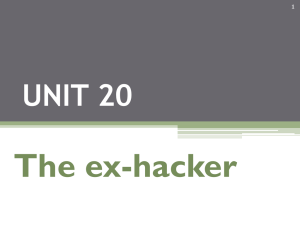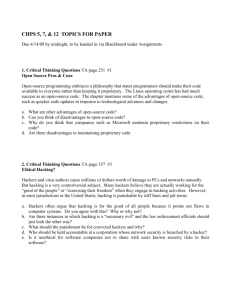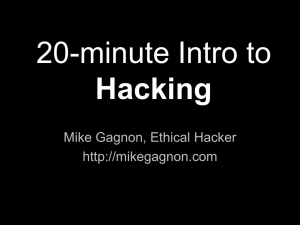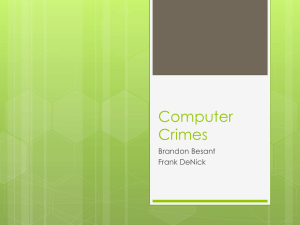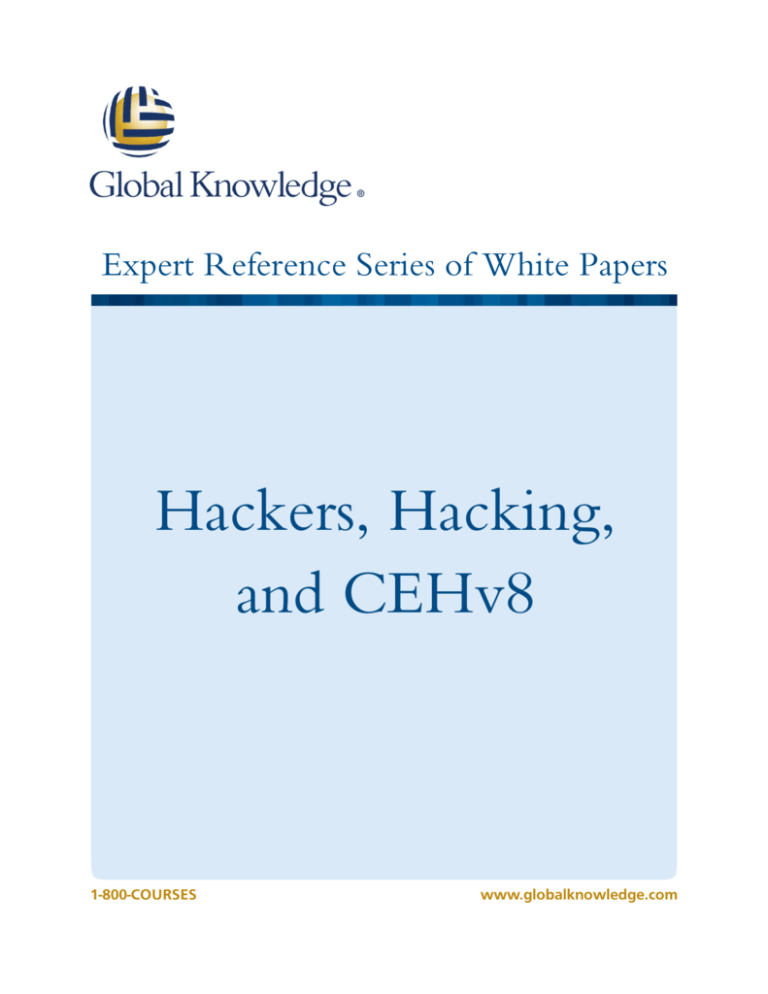
Expert Reference Series of White Papers
Hackers, Hacking,
and CEHv8
1-800-COURSES
www.globalknowledge.com
Hackers, Hacking, and CEHv8
Bob Withers CEH, CEI, CISSP, Security+
There are many things my father taught me here in this room.
He taught me: keep your friends close and your friends closer.
-Michael Corleone
Introduction
Cybersecurity makes the news regularly. Whether it is the Stuxnet worm attacking the Iranian nuclear program,
the Zeus botnet pillaging peoples’ bank accounts, the Syrian Cyber Army taking down The New York Times
website (or for that matter, Chinese hackers breaking into the same organization), we hear about cyber-attacks
regularly in the press. Moreover, we may have been the victim of one of these attacks, including identity theft
and financial fraud.
The security landscape has changed dramatically in the last 15 years, and particularly since the events of 9/11.
You’ll notice I said “security landscape” and that’s true in general. While terrorist attacks are incredibly rare in the
United States, as Bruce Schneier points out 1, he says that we tend to overemphasize the risk of the unusual 2.
This isn’t to discount the threats of military, transnational, or socio-politically motivated cyber-attacks, but a
bigger risk is from hacking that can be monetized: Identity theft, financial fraud, industrial espionage, theft of
intellectual property, and financial disruption.
According to www.DataLossDB.org, the largest data breach in history was the theft of 152 million usernames and
passwords from Adobe.com, closely followed by the Shanghai Roadway D&B Marketing hack. But, if you add up
the next five largest data breaches, they add up to an astounding 531,000,000 records 3. Apocryphally, the
famous depression-era bank robber named Willie Sutton said that he robbed banks “Because that’s where the
money is.” 4 The same question should be asked about why people hack on the internet?
Who’s the Hacker and Why Do They Hack?
In US Criminal Law, a crime requires means, motive, and opportunity 5. Unfortunately, it also requires a criminal
and a victim. A weapon is required often, but not always. Cyber-crime is no different, other than having the crime
occur electronically and intangibly.
The term “hacker” has a long and noble heritage. Hackney drivers, going back to the 17th century, were valued
for their resourcefulness in navigating the streets of London and environs 6. Hack writers provide the ability to
produce written works (articles, news stories, fiction) on short notice 7. In software, a hack was an elegant piece
of code that accomplished its task with minimal effort 8.
At the end of the ARPANET and the dawn of the Internet, hackers were mostly explorers and experimenters.
Largely because of the limitations of the computers of the era by which hackers took delight in creating the most
efficient, esoteric code to optimize system performance. Curiosity drove a lot of the deliberate and accidental
incidents on the nascent Internet. Hackers, such as The Mentor, posted manifestos to state their purpose and
interests 9.
Today, the hacking landscape is far more diverse. Most hacking seems to be socio-politically or financially
motivated. Sometimes, the motives are indistinguishable.
Copyright ©2014 Global Knowledge Training LLC. All rights reserved.
2
Transnational hacking and espionage are tools of modern warfare. Many countries on the planet are creating
cyber armies, including the United States 10. The North Korean Army very famously posted images of their cyber
army 11.
Cyber-crime affects nearly every American. Criminals pursue personal information that can be monetized,
including financial, credit, and personal information. Identity theft, as well as banking and credit fraud, have a
massive cost on the US economy 12.
So, then, who are the hackers? Broadly speaking, we can describe them in a few categories:
•
The Script-Kiddie. These are the explorers and adventurers who probe systems on the Internet for fun,
for curiosity, or exploration. Kevin Mitnik describes himself as just such an explorer13.
•
The Cyber-Criminal. Organized crime costs organizations $11.56 million per year per organization that’s
affected 14. According to The Wall Street Journal, cyber-crime and cyber-espionage cost $100 billion per
year 15.
•
The Cyber-Spy. Between the Chinese government’s theft of the plans for the new J20 fighter-plane 16,
the failure of Solyndra 17, and Anna Chapman 18, governmental and transnational organizations are
working to gain industrial and military secrets.
•
The Cyber-Terrorist. The threat of cyber-terrorism and related attacks against critical infrastructure,
power and water systems, banking systems, financial institutions, and other related portions of our
society threaten our way of life. Whether it is an attack against the power grid, as happened in the
Brazilian state of Espirito Santo 19, or a patriotic hacker called th3j35t3r (The Jester) 20 taking down the
website of the Taliban, denial-of-service (DoS) attacks serve to further the message and position of the
political or religious cause.
•
The Hacktivist. Perhaps, we can combine Hacktivism with the category of the cyber-terrorist, but the
purpose of the Hacktivist is to promote their message and support their cause. The group Anonymous,
for example, launched their cyber-attacks in support of WikiLeaks and other organizations 21, and in
retribution for perceived slights 22.
Labeling the hackers doesn’t really describe the motive, opportunity, or weapon. The motive is to create or
support power. Power may be religious, political, or financial. It may be to preserve or expand the power base.
The opportunity and the weapon are closely tied. Because the world is so interdependent on networked and
internetworked services, cyber-attacks provide an easy mechanism.
What Hackers Are Looking For and How They Get It
For the hacker, digital information that can be monetized is the Holy Grail. The process is rather straightforward:
perform reconnaissance, break in, maintain access, and try (as best as you can) to cover over the intrusion.
Every system or computer or network is vulnerable to attack. Vulnerabilities arise because of software bugs (no
software is perfect 23), misconfigurations (both from the manufacturer and operator-induced), default
configurations, and passwords. Many of these are well known, but others are unknown or unpatched by the
software provider. These zero-day exploits often lead to system and network intrusions.
Copyright ©2014 Global Knowledge Training LLC. All rights reserved.
3
Fundamentally, there are four steps in just about any hack-attack:
1.
2.
3.
4.
Reconnaissance
Penetration
Maintaining access
Covering tracks
Although the last two steps aren’t strictly necessary, they are helpful in providing down-the-road access and also
in helping the preventing the victim from knowing that they have been victimized.
Reconnaissance is the process of gathering as much information as possible about the target/victim’s
environment. I’ll point out that I didn’t specify just the network or systems undergoing this footprinting.
Reconnaissance, then, involves a holistic view of the target. We begin the investigation of any organization by
looking at its footprint on the Internet. What are the company websites? Do they expose information about the
company and its make-up? Who are the principal individuals in an organization and what’s the corporate
culture? Are email addresses and other confidential information visible?
By surfing search engines, can an attacker glean other information such as office locations, physical security,
information posted about network, and system configurations? Is too much information (also called TMI) being
released both through job sites, as well as social networks such as Facebook, LinkedIn, and so on?
So far, our reconnaissance has been almost completely passive. As in the physical world, stealth is critical. So, the
beginning of the footprinting process interacts as little as possible with the subject of the analysis.
Passive analysis has its limits, however. We may be able to identify Internet-facing systems, for example, but not
their operating systems or applications providing services. The Domain Naming System (DNS) will help us
inventory systems and applications that provide services to Internet users. We may not, however, be able to
identify supporting systems. For example, is there a database system supporting a website? What software and
operating systems provide those data services?
To find these details, we will need to become more active in our reconnaissance. Scanning and enumeration
allow us to probe deeper into an organization’s infrastructure. Hackers look for live systems, the TCP and UDP
ports that provide services, the applications providing those services, and they identify the operating system and
computer architecture in the process, as well as any vulnerabilities that may be obvious or yield to scanning tools.
Following reconnaissance, the next step is to actually penetrate the target/victim environment. In certified ethical
hacking (CEH) parlance, this is called system hacking. Using the handyman metaphor, hackers have many tools in
their tool belt. These include:
•
Breaking passwords. This is very often the first (and most effective) mechanism for penetrating a system
or network. Passwords can be guessed, intercepted as network traffic, retrieved directly from systems,
broken with various brute force, and other cracking attacks. I’ll point out that passwords can be stored
and transmitted openly (as with unprotected websites,) encrypted (in which case, they can be retrieved),
or hashed. In the latter, systems store a digest of the password and the hacker’s task is to reverseengineer the original plain text.
Copyright ©2014 Global Knowledge Training LLC. All rights reserved.
4
•
Hacking websites. Coming back to Willie Sutton, websites are hacked because “That’s where the data
is.” Websites (based on application frameworks, based on web server software, based on operating
systems, based on hardware connected to networks) create some of the most complex systems we have.
Compounding the problem, web administrators have the mission to provide the content for their
websites. They are not information-security professionals; they are technologists who have a job to do—
provide the support for web content.
Hackers attack websites at six tiers: defacement, DoS, attacking the website, attacking the web
infrastructure, attacking the database underneath the web server, and attacking the web client. We will
talk about DoS more broadly in a few moments.
Whether to a spread political, religious, or social message (or “just because they can”), we see website
defacement is a common problem. Usually because of misconfiguration or software bugs, defaced
websites often display messages related to the cause of the attacker.
Because websites facing the Internet are often in protected zones, breaking into the web server can lead
to further attacks within the network. Internet-facing websites usually reside within screened or
protected subnets, often called DMZs. Breaking into a web server can lead to further attacks within the
DMZ or into the corporate networks behind them.
The web infrastructure provides support connecting the website and the underlying services. Challenging
the web infrastructure may provide the same level of access to the database system or to the DMZ.
Databases underneath web servers provide a wealth of personally identifiable information (PII),
including email addresses, contact information, and (often) credit card or other information that can be
used for identity theft.
Finally, the trust between the web server and the web client can be violated. With both cross-site
scripting (XSS) and cross-site request forgery (CSRF), the web browser can be manipulated to perform
actions such as information theft, redirecting the client to a new website, delivery of malware, and
attacks against other web servers.
•
Malware. Commonly, malware is defined as malicious software. Originally from French, mal, means sick,
ill, or bad. We can look at four different types of malware, understanding that there is a large overlap
between them. Trojans, named for the story of the Trojan horse from the Homeric poems about the
Peloponnesian wars, are ways of maintaining remote control. Aside from providing access to the
network over time (more about that, later), these also allow large-scale remote control of systems in the
eponymously named botnets. Other kinds of malware include viruses and worms, which are selfpropagating software often used to carry Trojans, and rootkits, which mask the presence of malware.
•
Network Interception. Often called sniffing, network interception involves eavesdropping on network
communications to allow the gathering of data. The three principal purposes of sniffing are to steal
passwords and other access information, usurp someone else’s network access (session hijack), and
generally observe and record network communications. Wireless networks often provide the simplest
media to sniff, but encryption will complicate the attack. Much like password-cracking, web cracking
often involves retrieving the password or passphrase to a network. Other network interception often
involves penetrating the network and insinuating a network-tap in appropriate locations.
Copyright ©2014 Global Knowledge Training LLC. All rights reserved.
5
•
Denial of Service. Most commonly, we associate DoS with attacks on websites or other related services.
The primary purpose of a DoS attack is to render a service unusable on the Internet. Whether for social,
religious, governmental, political purposes, or “just for the fun of it”—DoS attacks have been in the news
over the last few years. A style of attack, using botnets, allows the attack to be spread across
(potentially) millions of systems to render networks and systems inoperable. These distributed denial of
service (DDoS) attacks have brought down major networks. DDoS attacks can also be used to mask
another attack or set of attacks.
Once a system or network has been penetrated, that may be enough. Consider the case of the thief who makes
off with millions of credit cards from a website. More often, hackers require continuous access to a network in
order to perpetrate their crime. Maintaining access is the process continuing control of the victim network or
systems. Trojans and other malware, including those propagated by viruses and worms, provide this remoteaccess and remote-control.
The late science fiction author, Robert Heinlein, famously said “The only crime is getting caught.” Covering tracks
is the process of attempting to erase tracks of the intrusion and the actions of the attacker. Dr. Clifford Stoll’s
1988 book, The Cuckoo’s Egg, describes one of the earliest excursions into the hacker underground.
Ethical Hacking
Hackers are continually attacking networks and systems. Whether these attacks are motivated by financial goals
(such as stealing personal or banking and credit information), social and political goals (the so-called hacktivists),
exploration, mischief, or just curiosity, there are really only two purposes: to steal information or to execute a
DoS attack.
When one performs the same acts as the attacker, but for defensive purposes, the security professional is looking
to identify the vulnerabilities and take advantage of them. This is in the same way that the hackers are
systematically attacking a business’ network.
When a security professional hacks their own networks or is hired to do this on behalf of a client, we call this
ethical hacking. There are other names for the activity, as well: penetration testing, red-teaming, tiger-teaming,
and security testing. Regardless of the name, the goals are to identify and exploit system and network
vulnerabilities. Unlike the attacker, the purpose of the exercise is to identify the flaws so they can be fixed. In
ethical hacking, remediation is crucial to enhancing an organization’s security posture.
The ethical hacker, with the emphasis on ethics, is a computer and network security professional who brings the
same skills and methodology as the attacker to bear on a system and network. The goal of the ethical hacker is
to strengthen the security of the environment.
There are several dimensions to conducting a security analysis using the ethical hacking methodology. First is the
level of intrusiveness. A security analysis may scale from a simple scan of vulnerabilities, using industry-standard
tools, to a complete break-in in a full-blown penetration test.
Secondly, the attack may come solely from the outside (called a black-box test), completely from the inside
(white-box), or from the position of a malicious-but-unknowing insider (gray-box) test. Black-box tests are often
performed without the knowledge of the maintainers of a network. White-box tests, on the other hand, are
designed to be interactive with the network security infrastructure and have the goal of seeing how a network
responds to a security test. Lastly, since a large portion of security violations come from inside any network’s
firewalls, gray-box tests pose as a malicious insider.
Copyright ©2014 Global Knowledge Training LLC. All rights reserved.
6
One of the key factors of an ethical hack is abiding by the statement of work (SOW), which defines the scope of
the allowable and disallowed actions. An ethical hack’s work does not exceed the constraints of the project. If a
particular test is not allowed, the security professional should avoid it.
Any discussion of ethical hacking would be lacking without a discussion of the risks. Whether performing a
relatively passive vulnerability scan or a fully intrusive penetration test, there are the risks of causing damage.
Network scans can flood networks and other activity can become a DoS attack. Anyone performing a security
analysis should be aware that they can inflict the damage that they are trying to avoid.
What is CEH?
Jay Bavisi and Haja Mohideen (the founders of EC-Council and the creators of the Certified Ethical Hacking and
Countermeasures program after September 11th, 2001 24), built the CEH program as a new kind of security
program that was based on offensive security.
CEH is different from most other cybersecurity training programs in that it emphasizes the tactical aspects of
cyber-defense. Most cybersecurity classes teach the traditional aspects of protecting systems. They include limiting
the functions of a system, hardening the infrastructure and services, patching, policy-and-procedure. Instead, CEH
teaches about penetration testing and the tools and techniques to conduct a red-team exercise.
The program teaches the fundamentals of hacking. The ethical part of CEH comes from what one does with the
knowledge gained. The skills we teach in the CEH class include: password cracking, privilege escalation, use of
malware (such as Trojans, worms-and-viruses, and rootkits), session hijack, exploitation of vulnerabilities (such as
buffer overflows), and web hacking.
Mirroring the hacking cycle, the purpose of CEH is to teach our students the essential skills required to emulate
and replicate the attacks on a network and systems. By performing the same exploits as the attacker on the
Internet, defenders can (hopefully) discover the holes in their networks before the adversaries.
If system defenders can identify the vulnerabilities, then they can define the defenses. But, without that
knowledge, they merely remain vulnerable to attack.
Who Is This For?
Admittedly, the idea of being taught to hack is appealing, at both an intellectual and visceral level. Many people
will think about the appeal of the illicit nature of hacking. On the other hand, ethical hacking requires discipline
and methodology. Any penetration test is a formal project with a statement of work, timeframes, deliverables,
and defined outputs.
Obviously, the CEH program is for individuals employed in cyber-defense. Cyber-operations employees, as well as
those employed in network and security operations centers, are ideal students for the CEH program. They of
course can, however, be a benefit to systems administrators, network managers, and application programmers.
Information technology auditors can also benefit because they gain the skills necessary for understanding the
recommendations they make—how to conform to “best practices” and why.
Network support and management personnel face the challenge of maintaining and monitoring their networks.
They also have the responsibilities for repairing abnormal situations and for incident response. Since network
hacks are commonplace, network support and operations groups can learn from the experiences of attacking the
networks they defend. Wired network and wireless hacking are of particular interest to this audience.
Copyright ©2014 Global Knowledge Training LLC. All rights reserved.
7
Attacks, such as web defacement and SQL injection, make the news because of website defacements or the theft
of financial and personal information from Internet-facing servers. Additionally, organizations are rightly
concerned with Internet-based attacks such as DoS and their distributed cousins. Web and database
administrators have to deal with higher layers of complexity as they support web servers, application platforms
and frameworks, and home-grown sites on top of all of the rest of the infrastructure. Over 25% of the content in
the CEHv8 class directly addresses web attacks and related services. This makes the course essential for web and
database administrators.
It has been said that, “The difference between hardware and software is that hardware breaks; software comes
broken.” Developers (whether application, mobile, web, or database) can benefit from the hacking and analysis
skills that are taught in class. The aspects of the class related to network and infrastructure security directly affect
application development because that is the environment where the software runs.
Security operations centers, policy analysts, and specialists in incidence response use the CEHv8 to learn what
hackers are trying to do to their networks and systems. The class samples hacking techniques and tools, and
demonstrates their effects. After all, the first step in incidence response is figuring out that something unusual
happened. After that, the classification and remediation of the incident require an understanding of the event
and the consequences.
Global Knowledge offers most of their classes as public sessions and onsite to businesses, governments, or other
organizations. I had the pleasure of teaching a CEH class to a group of IT auditors at a major East Coast
accounting firm. The room was filled with senior auditors, investigators, and so forth. They were all seasoned IT
professionals. During lunch, the lead auditor took me aside and said, “You know, Bob, we’ve been telling our
customer which practices to follow and which behaviors to avoid. But, we never knew why they were considered
best practices. You’ve been showing us all week why we say what we do!” In other words, audit and control
specialists and Information Assurance professionals are natural candidates for the class.
What’s New in CEHv8
The CEHv8 course contains 20 modules, compared to 19 with the previous class version (7). The new module
covers mobile devices, mobile threats, and cellular hacking. In addition, each of the other modules has been
updated to reflect the latest tools, techniques, and threats.
There are also 20 additional labs in the course. These labs focus on modern attacks, including dedicated websites
for web hacking and a selection of tools that operate in modern environments.
Each student receives courseware with color copies of all the presentation slides. These materials have a similar
look-and-feel to Microsoft’s tile-like presentation in Windows 8.Additionally, each student who receives a printedcopy of the courseware also gets access to an electronic copy of the student text. While the printed courseware
contains the slides (and the labs,) the electronic courseware includes a discussion of each topic for more in-depth
understanding.
Lastly, the DVD tools distribution has been updated and refined, with each section of tools matching the
courseware modules and labs.
Copyright ©2014 Global Knowledge Training LLC. All rights reserved.
8
Complete Outline
The CEHv8 class covers the range of hacking and cyber-security topics, from the foundational to advanced topics,
including the need for security to buffer overflows and web hacking. In the course the chapters are:
•
Introduction to Ethical Hacking:
Offensive security differs from traditional practices in that the latter depends on implementation of best
practices, system hardening, and responding to threats while Ethical Hacking looks to exploit
vulnerabilities with the purpose of remediating the problems. This module introduces current security
issues, the hacking cycle, the reasons for implementing security, and provides an overview of
vulnerability analysis.
•
Footprinting and Reconnaissance:
Any attack on a network, whether malicious or for defensive purposes, must start with reconnaissance.
This is the process of identifying networks, identifying the systems within those networks, finding the
services on those systems and the underlying operating systems and applications which serve those
capabilities. Additionally, other reconnaissance includes identification of physical security, identifying web
presences, and understanding the individuals within an organization. Footprinting is the process of
performing passive reconnaissance, including web searches, using online resources (such as social
networking and business intelligence sites), and people searches to build a profile of an organization and
individuals.
80–90% of the effort to exploit systems comes from the reconnaissance phase and footprinting provides
a wealth of information. The important aspect of footprinting is that it is almost completely passive. The
person performing the reconnaissance takes great pains to avoid any action that would warn the target
that they are being reconnoitered. Use of web services, proxies, and Internet-based services form the
basis of footprinting.
•
Scanning Networks:
Footprinting has significant limitations when one is identifying Internet-facing systems. First, we cannot
find systems that are not published to the Internet through mechanisms such as the DNS. Secondly, we
may not be able to identify the applications providing the services we’ve found, the operating systems,
and platform architectures, because finding that information requires interacting with the target
systems.
Scanning is the process of using tools to identify all of these characteristics, as well as misconfigurations,
unpatched systems, and other vulnerabilities. These activities can generate significant network noise, so
the ethical hacker must take pains to perform these tests as stealthily as possible. In hacker parlance, we
want to avoid “rattling the doorknobs.”
•
Enumeration:
We complete the reconnaissance phase by finding other information that can be used to complete the
attack. Enumeration is the process of discovering network-shared resources, distributed applications, user
names and user groups, and (if possible) security settings.
Copyright ©2014 Global Knowledge Training LLC. All rights reserved.
9
•
System Hacking:
Traditionally, the skills in this module are those most commonly associated with hacking—both malicious
and defensive. The first step is system penetration. Next, we escalate our privileges to become
administrators on the target system. Administrator privilege allows us to install programs including
several varieties of malware and to cover our tracks to avoid detection. The goals of the malware are to
provide continued remote access, log keystrokes, and hide the presence of the malware.
•
Trojans and Backdoors:
In system hacking, we use the actions of the hacker to plant remote access software. This software is
often known as a RAT or Remote Access Trojan. RATs, as well as other spyware, allow us to re-enter the
network or to propagate access throughout the victim network.
•
Viruses and Worms:
Self-propagating software used to be the fodder of science fiction. But, beginning about 25 years ago,
that changed as malicious software made its presence known on the Internet. Both viruses and worms
are self-propagating, but the former needs to attach itself to a host application or part of the system.
The virus executes when the carrier mechanism executes and it attaches itself to the host. As systems
reboot or infected applications run, the viral code is invoked and runs and often propagates itself.
Worms operate similarly with the exception that they run autonomously and do not need a host
application or service.
Viruses and worms are often used for destructive purposes. More often, however, they carry Trojans to
extend cyber-criminals’ access to victim systems. Botnets, specialized version of the Trojan, can be
widespread infections. These bots are most commonly used to either send secure spam email for criminal
purposes or to launch DoS attacks.
•
Sniffers:
Another tool hackers use to steal data is a sniffer, whose purpose is to intercept network traffic. Many
network protocols send their data in the open, without any encryption. When a cyber-criminal uses a
sniffer, they can capture the information, modify it in flight, or replay and re-inject it. On wired
networks, this may require subverting the switching infrastructure. Wireless networks, however, are
subject to easy sniffing if there is not encryption.
•
Social Engineering:
Donn Parker, in his seminal book 25, talks about the human factor being the weakest link in the security
chain. Social engineering is often called hacking the human. This module explains the various techniques
including using phishing email, use of intimidation and reputation, and the tools to facilitate social
engineering.
•
Denial of Service:
We traditionally associate DoS with groups attacking websites for social, political, or religious causes.
These so-called “hacktivists” will either deface websites or they will make Internet services unavailable for
legitimate use. The attacks of “Anonymous 26 in support of WikiLeaks or against government websites
are examples of this type of activity.
The other purpose for DoS attacks is to be diversionary. If the defenders are kept busy, the hackers may
be executing another simultaneous attack. This module covers DoS attacks and their siblings, DDoS
hacks. We also talk about botnets and their command-and-control systems.
Copyright ©2014 Global Knowledge Training LLC. All rights reserved.
10
•
Hacking Web Servers:
The CEHv8 class divides web hacking into three portions: Hacking web servers, web applications, and
attacking the underlying databases behind the web servers. Web servers and their applications are
intrinsically more complex than other environments because we have the underlying network-systemand-operating-system. On top of that, the web server is also a large, complex application whereupon
developers use pre-built frameworks to implement the customer-facing web application.
In this module, we examine the impact of differing web server architectures, exploiting vulnerabilities of
these platforms, and server hardening. We also take an in-depth look at patch-management and its
effects on system security.
•
Hacking Web Applications:
Web applications have become much more complex over the last several years. With the advent of the
so-called Web 2.0 services (as well as mobile applications), the opportunities for attack expand with the
complexity of the environment.
In this module, we examine the advanced web technologies such as SOAP, AJAX, and JAVA, as well as
the infrastructures that provide content-and-media-rich websites. Beyond attacking the Web2.0 services,
we also look at violating the trust between the web client and server with both XSS and XSRF. In this
module, we exploit a specifically designed website to demonstrate the concepts of attacking web
applications.
•
SQL Injection:
Databases underlie most modern websites. They provide services such as a storage location for a web
server’s web pages, information about how the pages are to be presented, and are facilitators for
interacting with the site itself. Often, websites will have login mechanisms and even the ability to post
comments or reply to surveys.
All of this information is stored in the database servers that support the web server and its applications.
Injection attacks allow the hacker to interact with the systems behind the web presence. SQL injection
allows a hacker to bypass login mechanisms and to interact directly with the database management
system (DBMS). In this module, we examine the ways to use the Structured Query Language (SQL) to
proxy through web servers to directly command the DBMS. This may be to steal the stored data (such as
usernames, passwords, credit card or social security numbers, or other personally-identifiable-data),
modify existing information such as bank accounts, or to destroy the data in the database and executing
a DoS attack.
Like the lab in the Web Application module, we use specially crafted websites to demonstrate the tools
and techniques for SQL injection.
•
Hacking Wireless Networks:
The advantage of wireless networks is that there are no wires. The disadvantage of wireless networks is
that there are no wires. Intrinsically, wired and switched networks provide some protection against
sniffing the network. That protection doesn’t exist in a broadcast radio environment using WiFi. Wireless
networks are then susceptible to eavesdropping, data modification, and spoofing (or faking) client or
access point information. Wireless encryption provides some protection, but even that can be attacked.
In this module, we examine the benefits and risks of wireless networks, the attacks against these
networks, and how to hack the systems attached to wireless environments. We also examine the process
of breaking the encryption used to protect the on-air signals for these services. As part of this module,
Copyright ©2014 Global Knowledge Training LLC. All rights reserved.
11
we also look at the risks and protections for Bluetooth devices when they are connected to the network
infrastructure or mobile devices.
•
Mobile Device Hacking:
This past year, tablets outsold traditional PCs 27. In the third quarter of 2013, the Android operating
system made up 80% of all new mobile phone sales. Industry buzz says we are in the post-PC era 28. The
threats to mobile devices from traditional sources (such as theft and malware) extend from the
traditional security environment. There are two significant differences, however. First, is the mobile
nature of the victim. BYOD is taken to mean “Bring Your Own Device.” Many employees would rather
use their own PCs, tablets, or phones instead of the ones issued by their employers. Employers benefit
from the cost saving of moving the work to the employees’ devices. However, without proper security,
the mobile risks often exceed the benefits.
In other words, BYOD can also mean “Bring Your Own Destruction.” This module examines the mobile
landscape and hack attacks against the devices and the data upon them.
•
Evading IDS, Firewalls, and Honeypots:
The purpose of an ethical hack is to identify weaknesses in the network. By using the same techniques as
the attackers, the penetration tester finds and exploits the target’s vulnerabilities. One significant
difference is that the person hacking for defensive purposes recommends solutions to the exploits they
find.
A key aspect of this is the hacker’s identification of defensive systems and being able to successfully
evade them. In this module, we look at the use and implementation of intrusion detection systems (IDS),
network firewall systems, and honeypot servers. A honeypot is a specifically instrumented computer
system whose purpose is to trigger alarms when probed by hackers.
In this module, we examine the role of these systems, and detection and evasion techniques. The goal of
this module is to provide the network defenders with information about how hackers are circumventing
the network defenses.
•
Buffer Overflows:
Looking at software development, programmers write buggy code. This is simply a fact of life. The best
code, or even the simplest, will have flaws because of the programmer’s errors or faults in the underlying
supporting operating system and infrastructure. After all, an operating system on a computer is just
another computer program whose role is to control the machine. One of the earliest names for an
operating system was the Master Control Program (MCP)—with due reference to the movie TRON.
Hackers will exploit these failings in software systems through a variety of mechanisms and tools. The
Metasploit Framework, for example, allows both hackers and defenders to exploit bugs in the software.
Using buffer overflows, the attacker sends specifically malcrafted input data to a program. This data
includes the text representation of computer instructions which overwrite legitimate program code and
sufficient padding to position the new instructions at the correct location in an application’s system
memory. Using buffer overflows, the hacker attempts to subvert the running application or the
underling operating system to their own purposes.
Copyright ©2014 Global Knowledge Training LLC. All rights reserved.
12
•
Cryptography:
For more than 3,000 years, people have worried about eavesdroppers intercepting communications. This
includes personal communications, military and diplomatic communiqués, and other confidential
information. Encryption and the use of other ciphers and data-hiding techniques have helped protect the
confidentiality of these communications. Generally speaking, cryptography can be viewed as codemaking and cryptology as code-breaking. 29 This module examines the use of cryptography, cryptographic
techniques, and the ways of breaking cryptographically encoded information. Because defenders need
to protect their data in flight and at rest, and because hackers want to intercept that information,
cryptography is foundational to strong security mechanisms. In this module, we review the principles of
cryptography and then learn about applying cryptology to crack the protected information.
•
Penetration Testing:
We return to the key question of ethical hacking—why are we doing this? When we posit that the
defenders have to win all the battles, but the attacker needs only one, then defensive security is merely
a holding action. Using the same techniques that the attackers use to find vulnerabilities and exploit
them, the ethical hacker seeks out vulnerabilities and exploits them to see if an intrusion can be
successful. Other names for the process include red-teaming, tiger-teaming, or penetration-testing.
Beyond being able to successfully exploit weaknesses in system and network defenses, the purpose of
penetration testing is to produce actionable results that will help the defenders strengthen their
defenses. The end result of a penetration test is a report, with clear issues and actions that can be used
to strengthen the security of the target environment.
Penetration testing is the formalized action of putting the work to use in protecting the client’s
environment. The CEHv8 class covers the tools and techniques to perform an ethical hack. Following this,
the EC Council ECSA/LPT program implements the formal testing and reporting methodologies.
The CEHv8 Exam
EC-Council, through the CEHv8 exam has achieved ANSI 17024 Certification. The criteria for Personnel
Certification Accreditation, demonstrates that the certification process “…is conducted in a consistent,
comparable, and reliable manner.” Through ANSI’s review process, ANSI has certified EC-Council’s quality
process. 30
This process, along with US Department of Defense Directive 8570 endorsement, speaks to the quality and rigor
of the certification.
With 125 questions and a passing score of 70%, this four-hour exam measures the skills needed to perform the
duties that this class teaches. Students who attend Global Knowledge CEHv8 classes automatically receive a test
voucher to take the exam at VUE testing centers.
Exam Objectives
From the EC-Council website 31, the CEHv8 exam tests the following areas:
•
Background (5 questions, 4%): Networking, web and system technologies, communications protocols,
malware operations, mobile operations, telecommunications, and backup and archiving
•
Analysis/Assessment (16 questions, 13%): Data and systems analysis, risk assessments and technical
assessment methods
Copyright ©2014 Global Knowledge Training LLC. All rights reserved.
13
•
Security (31 questions, 25%): Systems security controls, application/fileserver, firewalls, cryptography,
network and physical security, threat modeling, verification procedures, social engineering, vulnerability
scanners, privacy/confidentiality, biometrics, wireless technology, trusted networks, and vulnerabilities
•
Tools/Systems/Program (40 questions, 32%): Network/host based intrusion, network/wireless sniffers,
access control mechanisms. cryptography techniques, programming and scripting languages, boundary
protection applications. subnetting, port scanning, domain name system, routes/switches/modems,
vulnerability scanners, operating environments, antivirus, log analysis tools, security models, exploitation
tools, and database structures
•
Procedures/Methodology (25 questions, 20%): Cryptography, public key infrastructure, security
architecture, service oriented architecture, information security incident response, n-tier application
design, TCP/IP networking, and security testing methodology
•
Regulation/policy (5 questions, 4%): Security policy, and compliance regulations
•
Ethics (3 questions, 2%): Professional code of conduct, appropriateness of hacking activities
How to Proceed from Here?
Audiences for the CEHv8 class range from working security professionals, to software developers, to website
administrators, to systems engineers, to operations and network managers. Unlike other training programs and
certifications, the CEHv8 program focuses on offensive security: how to hack and how to respond to the hacking
incident. The CEHv8 course and exam are appropriate for the individual and group whose responsibilities include
cyber-defense and incidence response. The program teaches the offensive security skills needed to respond to the
changes in the security landscape.
According to the warrior-general Sun Tzu:
Hence the saying: If you know the enemy and know yourself, you need not fear the result of a hundred
battles. If you know yourself but not the enemy, for every victory gained you will also suffer a defeat. If
you know neither the enemy nor yourself, you will succumb in every battle.
These words, from The Art of War, describe how an understanding of your enemy ensures your success against
them in battle. Our battleground is not a field with opposing warriors, but rather, opposing cyber-forces. In this
conflict, both the defenders and attackers must use the same tools to gain the same advantages. You can only
successfully defend when you understand your opponent, their techniques, and how they use their weapons.
Copyright ©2014 Global Knowledge Training LLC. All rights reserved.
14
Learn More
Learn more about how you can improve productivity, enhance efficiency, and sharpen your competitive edge
through training. Global Knowledge offers a comprehensive menu of cybersecurity courses, including:
Certified Ethical Hacker v8
Cybersecurity Foundations
CompTIA Advanced Security Practitioner (CASP) Prep Course
RSA Threat Intelligence
Cyber Security Compliance & Mobility Course (CSCMC)
IBM Security Systems Courses
Visit www.globalknowledge.com or call 1-800-COURSES (1-800-268-7737) to speak with a Global Knowledge
training advisor.
About the Author
Bob Withers is a Principal Consultant with BWA, Inc., a cybersecurity training and consulting company specializing
in healthcare security. He is also a Master Trainer for Global Knowledge, teaching both cybersecurity and
Microsoft curricula. Bob holds the CISSP certification from ISC2, C|EH, E|CSA/LPT, C|HFI, and C|EI certifications
from EC Council, MCSE, and MCT accreditation from Microsoft, and many other industry-standard certifications.
With more than 30 years of information technology and cybersecurity experience, Bob is also an author and
speaker at security conferences across North America.
Copyright ©2014 Global Knowledge Training LLC. All rights reserved.
15
Endnotes
1
https://www.schneier.com/blog/archives/2013/02/jared_diamond_o.html
https://www.schneier.com/blog/archives/2006/11/perceived_risk_2.html
3
http://datalossdb.org/ as of 10/21/13
4
http://en.wikipedia.org/wiki/Willie_Sutton
5
http://en.wikipedia.org/wiki/Means,_motive,_and_opportunity
6
http://en.wikipedia.org/wiki/Hackney_carriage#Etymology
7
http://en.wikipedia.org/wiki/Hack_writer
8
http://quotes.cat-v.org/programming/
9
http://www.mithral.com/~beberg/manifesto.html, 1986
10
http://www.stratcom.mil/factsheets/Cyber_Command/
11
http://www.telegraph.co.uk/news/worldnews/asia/northkorea/10239283/North-Korea-builds-online-trollarmy-of-3000.html
12
http://www.infolawgroup.com/2013/04/articles/information-security/2013-dbir/
13
http://www.cbsnews.com/video/watch/?id=7380240n
14
http://www.internetnews.com/security/report-cybercrime-costs-11-56-million-per-organization.html
15
http://online.wsj.com/news/articles/SB10001424127887324328904578621880966242990
16
http://www.dailymail.co.uk/sciencetech/article-2146283/Chinas-stealth-jet-goes-strength-strength-U-S-airtechnology-falters-just-Chinese-rip-off.html
17
http://www.technologyreview.com/view/429625/solyndra-files-suit-against-chinese-solar-cartel/
18
http://gizmodo.com/5621350/russian-numbers-station-changes-broadcast#
19
http://www.huffingtonpost.com/2009/11/07/cyber-attacks-caused-braz_n_349530.html
20
http://www.youtube.com/watch?v=WeO44IWlkfU
21
http://arstechnica.com/tech-policy/2011/01/fbi-goes-after-anonymous-for-pro-wikileaks-ddos-attacks/
22
http://dailylounge.com/the-daily/entry/things-that-will-end-badly-company-trademarks-anonymous-logo
23
http://www.wired.com/software/coolapps/news/2005/11/69355?currentPage=all
24
http://www.cisse.info/news/24-speakers/128-jay-bavisi
25
Donn Parker, Fighting Computer Crime: A New Framework for Protecting Information
26
Parmy Olson, We Are Anonymous: Inside the Hacker World of LulzSec, Anonymous, and the Global Cyber
Insurgency
27
http://www.bbc.co.uk/news/technology-20052118
28
http://en.wikipedia.org/wiki/Post-PC_era
29
http://www.ciphermysteries.com/2009/02/03/cryptography-vs-cryptanalysis-vs-cryptology
30
http://www.eccouncil.org/ec-council-achieves-ansi-17024
31
https://www.eccouncil.org/Certification/exam-information/ceh-exam-312-50
2
Copyright ©2014 Global Knowledge Training LLC. All rights reserved.
16




